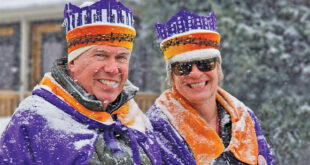History of the GCEA, Part 4
by Keriann Conroy and George Sibley
This is the fourth and final part of a history of electricity in the Upper Gunnison valley, celebrating the 80th anniversary of the Gunnison County Electric Association.
The Gunnison County Electric Association will hold its 80th annual meeting on June 25 at the GCEA Headquarters, west of Gunnison. All members are invited: dinner and voting at 5 p.m., business meeting at 6 p.m. with guest speaker Duane Highley, Tri-State G&T CEO. Election results at the end of the meeting.
We’ve moved quickly in this series through the history of the Gunnison County Electric Association, from its first annual meeting in 1939 with 114 members and $275 in the treasury, to today’s multi-million dollar cooperative with more than 10,000 members. Through the years, dozens of those members have served their fellows as representatives from the seven GCEA districts—some for heroic terms, like original board member Janet Allen, who served as secretary for 36 years.
Created from scratch under the Rural Electrification Administration, the GCEA has built 1,089 miles of lines distributing power from four substations. Originally intended primarily to light up ranch and farm country, the GCEA now also serves several growing towns and a number of “planned unit developments” throughout the Upper Gunnison Basin, and a major ski resort, two fish hatcheries, an internationally acclaimed biological field station and a National Recreation Area complex.
The GCEA began with 100 percent local power generation because they were too remote and too small for any investor-owned utility to bring them power—they even envisioned local renewable hydropower, but war production in the 1940s precluded that. Today, nearly all of the power comes from regional grids well beyond the valley—but there is once again growing interest in local renewable generation that the GCEA is moving to accommodate.
This interest was given a huge boost this year by Colorado’s House Bill 19-1261, the Climate Action Plan to Reduce Pollution. Signed into law by Governor Polis this April, the new legislation requires the state to reduce greenhouse gas emissions 50 percent by 2030, and 90 percent by 2050. To meet its goals, rather than fining emitters, Colorado is looking to its Air Quality Control Commission to develop rules and standards to reduce carbon dioxide, methane and other greenhouse gases. The commission will be responsible for reporting on the state’s progress every two years.
The bill sets the path for Colorado’s future, anticipating that the reduction of emissions “will create new markets, spur innovation, drive investments in low-carbon technologies and put Colorado squarely on the path to a modern, resilient, 100 percent clean economy.” Working out the details for this ambitious agenda will shape the future of all Colorado electric utilities.
For the GCEA, the cooperative is expected to decrease 80 percent of emissions caused by electricity sales by 2030. Veteran GCEA board member and former staffer Mark Daily foresees a move within the Gunnison Basin toward 100 percent renewable and sustainable electricity generation, stating, “Renewable energy generation is no longer an environmental issue; it is an economic issue.” As more and more coal plants are retired early, the prospect of an affordable, renewable future is coming on line.
Daily emphasizes the need for “an aggressive electricity conservation ethic and an honest willingness to work together instead of standing to promote our pet project or poking each other in the eye when we disagree.”
However, even with this standard of collaboration, concerning a 100 percent renewable future, Daily asserts, “The challenge is that no one knows how to do that yet, no matter what hype or marketing promotion you may read to the contrary.”
Mike McBride, GCEA’s chief executive officer, identifies several local obstacles for the GCEA’s service territory. A test windmill showed very little potential for wind power; and while there is usually an abundance of sun, solar arrays also require an abundance of space—eight acres for a one-megawatt array. He estimates that it would require “more than 1,000 acres” to generate the utility’s full demand. The Upper Gunnison Basin also lacks three-phase distribution lines to carry such loads. Such challenges leave the utility with a “challenging balancing act to develop solar.”
McBride wants to see a diversity of resources to the power supply but asserts, “Land issues will always make us reliant on outside power.” He also noted that the Endangered Species Act and its protection of the Gunnison sage grouse make the land issue even more complex.
The GCEA’s “outside power” supplier, Tri-State Generation & Transmission Association, is also fully aware of the new law. Under new chief executive officer Duane Highley, Tri-State bylaws have been changed to reflect the new state mandates, and new options are being considered by the board. McBride also acknowledges a moral commitment to Tri-State’s lenders, and the paydown of its debt. “I firmly believe in fulfilling one’s obligations,” he said. The GCEA and its members pay off its debt to Tri-State through rates, and in return Tri-State maintains the expensive distribution infrastructure required to power our valley. Though Taos and Delta-Montrose’s utilities are exploring a new set of options for their communities, McBride and the GCEA board see opportunity in sticking with the G&T to collaborate on redefining the path forward.
“With so many recent developments, it’s kind of like a perfect storm—in a good way,” McBride says.
Polly Oberosler, the newest member to the GCEA board, agrees with challenges to local development due to lack of three-phase power and the Endangered Species Act, but is hopeful for the future, so long as the members and cooperative think outside the box. “There are answers out there,” Oberosler states. “We just can’t have tunnel vision.” Creative thinking and collaboration remain prominent to the GCEA’s strategic plan.
Oberosler ultimately hopes that, whatever the future brings, the GCEA will remain a co-op. She advocates for a growing local generation component but acknowledges the continuing need for participation in the grid and its larger suppliers like Tri-State, which supply many important support functions as well as electric power. “A substation, for example,” she said, “has parts that cost millions. We need Tri-State’s support for that.
“But keep it a member-driven co-op,” she reiterates, “in control of our own destiny, as much as possible.”
 The Crested Butte News Serving the Gunnison Valley since 1999
The Crested Butte News Serving the Gunnison Valley since 1999



